May 14: this is not a lecture
 In a discussion of one classic
optimization problem I asked if cheetahs could swim. This question
was thoroughly researched by the capable Ms. Bloom
Leeds who found the following information:
In a discussion of one classic
optimization problem I asked if cheetahs could swim. This question
was thoroughly researched by the capable Ms. Bloom
Leeds who found the following information:
May 14: this is not a
lecture
 In a discussion of one classic
optimization problem I asked if cheetahs could swim. This question
was thoroughly researched by the capable Ms. Bloom
Leeds who found the following information:
In a discussion of one classic
optimization problem I asked if cheetahs could swim. This question
was thoroughly researched by the capable Ms. Bloom
Leeds who found the following information:
| Can cheetahs swim? | Yes, they are capable, but they usually need a good motivation to do it. Carnivore biologist Luke Hunter reported seeing two male cheetahs swim across a river to get to a female cheetah on the other side. |
In fact, straightforward research (including observation of many domestic cats) shows that not many felines like to swim. But the redoubtable Ms. Bloom Leeds provided further information about the Turkish Van, a kind of cat which likes to swim. To the right is a picture taken from the web page swimmingcats.com.
We did some further substitution problems.
John Henry
The Maple program can compute some antiderivatives. We
can, also. But we can compute ![]() sqrt(1+sqrt(1+sqrt(x))) dx, and Maple can't, not
even the latest version. The substitution u=sqrt(1+sqrt(1+sqrt(x)))
will do it. Then ((u2-1)2-1)2=x, so
a connection between du and dx can easily be deduced. Etc.
sqrt(1+sqrt(1+sqrt(x))) dx, and Maple can't, not
even the latest version. The substitution u=sqrt(1+sqrt(1+sqrt(x)))
will do it. Then ((u2-1)2-1)2=x, so
a connection between du and dx can easily be deduced. Etc.
Reminders about various review sessions and about the final exam were
said. And we parted, students and instructor, for the last time ...
Diary entry in progress! More to
come.
| The final exam for sections 21, 22, and 23 of Math 135 will be given Thursday, May 5, 4-7 PM, in Hickman 138 on the Douglass campus. Please try to be there on time, or even a bit early. Bring a graphing calculator, your student ID, and be familiar with the Official formula sheet for the final exam. |
| The lecturer will meet again on Sunday, May 1, from 6 PM to 8 PM in Hickman 216 and will have students go to the board and do problems from previous final exams which are related to the second half of the course. Helpful comments will be offered. Last Sunday most of these problems related to the first half of the course were discussed. |
| Mr. Jin, the recitation instructor, will hold a review session from 6 to 8 PM on Tuesday, May 3, in RAB 001, the usual classroom. He will discuss some of the Official review problems for the final exam |
Some WeBWorK problems
I did problems 3 and 7 and 9 in one version of WeBWorK.
#3
I think this was something like:
![]() (8x5+7)/x3 dx.
(8x5+7)/x3 dx.
One way to see
the answer is to play with the integrand. Break up the fraction:
(8x5+7)/x3=[8x5/x3]+[7/x3].
Then each term can be simplified: 8x2+7x-3. And
now the antiderivative is easy:
8(1/3)x3+7(-1/2)x-2+C.
#7
My version of this problem goes like this:
Find the Riemann sum associated with f(x)=2x2+3, n=3 and
the partition x0=0, x1=3, x2=4,
x3=6, of [0,6] when xk* is the right
end-point of [xk-1,xk]
Partitions and Riemann sums are complicated objects. Here the interval
is [0,6], and I think graphically.
Here's the interval with the partition marked:
0------3--4----6.
First chunk: 0------3.
Length of subinterval is 3-0=3. Sample point is 3. Therefore
we get f(3)(3).
Second chunk: 3--4.
Length of subinterval is 4-3=1. Sample point is 4. Therefore
we get f(4)(1).
Third chunk: 4----6.
Length of subinterval is 6-1=2. Sample point is 6. Therefore
we get f(6)(2).
The total will be f(3)(3)+f(4)(1)+f(6)(2). Since
f(x)=2x2+3, this total is
f(3)(3)+f(4)(1)+f(6)(2)=21(3)+35(1)+75(2).
#9
Here I have f(x)=-(1/2)x2-7. WeBWorK asks for a
formula for the Riemann sum, which is called Rn, which will
approximate the definite integral of f(x) on the interval [0,3] when
the interval is divided up into n equal pieces and the sample points
are taken at the right-hand sides of the subintervals. Further advice
is given: "You will need the summation formulas on page 287 of your
textbook." We are also asked for the limiting behavior of
Rn as n-->infinity (this should be the value of
the definite integral). We worked on this.
The details of this problem are obnoxious. Start with the interval
from 0 to 3, divided into n equal parts. Since the interval has length
3, the n equal parts will each have length 3/n. The partition "looks
like" this:
0--3/n--2(3/n)--3(3/n)--4(3/n)--......--n(3/n)
The starting point is 0 and the end is n(3/n) which is 3. What about
the "chunks" of the Riemann sum?
First chunk: 0------3/n.
Length of subinterval is 3/n. Sample point is 3/n. Therefore
we get f(3/n)(3/n).
Second chunk: 3/n--2(3/n).
Length of subinterval is 3/n. Sample point is 2(3/n). Therefore
we get f(2(3/n))(3/n).
Third chunk: 2(3/n)--3(3/n).
Length of subinterval is 3/n. Sample point is 3(3/n). Therefore
we get f(3(3/n))(3/n).
Etc.
Well, what I mean by this is we should add up f(i(3/n))(3/n) as i goes
from 1 to n. I am using i because that is the variable of summation
in the WeBWorK problem. The darn thing would look like
this:
SIGMAi=1nf(i(3/n))(3/n)=
SIGMAi=1n[-(1/2)(3i/n)2-7](3/n).
This is the same as
-[(27/2)/n3]SIGMAi=1ni2
-7SIGMAi=1n(3/n).
The summation formulas on page 287 can now be consulted. Sigh. For
example, SIGMAi=1ni2 is equal
to [n(n+1)(2n+1)/6]. All those folks in China and India knew this. And
SIGMAi=1n(3/n)=3. So the SIGMA
stuff gives a formula for Rn.
Rn=-[27n(n+1)(2n+1)]/[12n3]-21. Then using L'H
or some other method (can you tell I am not much interested?) I can
guess limn-->infinityRn. It is -(54/12)-21.
(The 108 and 12 come from the coefficient of n3 top and
bottom.)
Confession Since I am writing this without anyone "looking over
my shoulder" and checking, I admit that I made several mistakes in
getting the formula for Rn and had to redo it a few
times. This work is definitely easier to do the process in class,
where people frequently catch my errors!
Same computation with FTC
![]() 03-(1/2)x2-7 dx=-(1/6)x3-7x|03=-(1/6)33-21
(the values at x=0 are 0).
03-(1/2)x2-7 dx=-(1/6)x3-7x|03=-(1/6)33-21
(the values at x=0 are 0).
It turns out that -(54/12)-21 and -(1/6)33-21 are both
-51/2. The methods give the same answer.
Which way would you like to use?
Restating part of FTC
FTC stands for Fundamental Theorem of Calculus.
If F´(x)=f(x), then ![]() abf(x) dx=F(b)-F(a), abbreviated
F(x)|ab.
abf(x) dx=F(b)-F(a), abbreviated
F(x)|ab.
F(x) is called an indefinite integral or antiderivative or primitive
of f(x).
Example of FTC and a mild logical point
So over on the cute little side blackboard, I wrote:
![]() 01x2dx=(1/3)x3|01=(1/3)13-(1/3)03=(1/3)
01x2dx=(1/3)x3|01=(1/3)13-(1/3)03=(1/3)
![]() 01v2dv=(1/3)v3|01=(1/3)13-(1/3)03=(1/3)
01v2dv=(1/3)v3|01=(1/3)13-(1/3)03=(1/3)
![]() 01q2dq=(1/3)q3|01=(1/3)13-(1/3)03=(1/3)
01q2dq=(1/3)q3|01=(1/3)13-(1/3)03=(1/3)
The point I wanted to make here is that the x and the q and v are all
really irrelevant outside of the computations. The variables don't
change the answer. Logically these are dummy or
bound variables. They tell you what to do to what. Even a
program like Maple needs to be told things. For
example, you can consider the following dialogue (?) between
Maple and me.
>int(x^2); Error, (in int) wrong number (or type) of argumentsMaple tells me I must designate a dummy variable.
>int(x^2,x);
1
-x3
3
I tell it the dummy variable, and get the answer I expect. Now look:
>int(a^3*b^5,x);
a3b5x
Well, if x is the dummy variable, then what's there is a constant.
>int(a^3*b^5,b);
1
-a3b6
6
So Maple found the antiderivative now considering the
function with b as the variable.
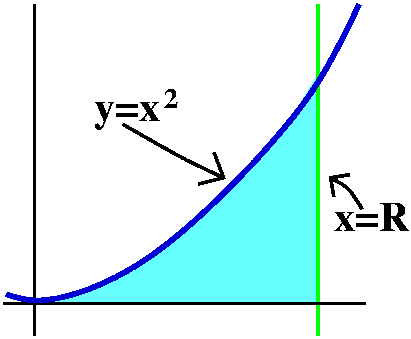
Silly FTC
Can we find a vertical line so that the region in the first quadrant
bounded by the line, the x-axis, and the graph y=x2 has
area equal to 57?
Let's call the line x=R. This just means that a certain definite
integral should be 57. So:
![]() 0Rx2dx=(1/3)x3|0R=(1/3)R3-(1/3)03=(1/3)R3
0Rx2dx=(1/3)x3|0R=(1/3)R3-(1/3)03=(1/3)R3
and we can get this to be 57 by solving (1/3)R3=57, so that
R=(3·57)1/3.
Halving area vertically
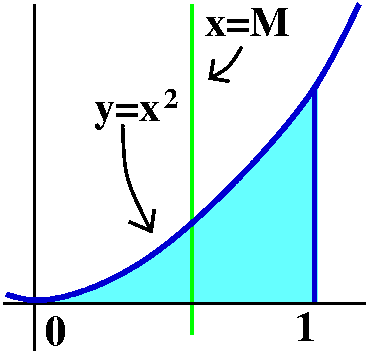 Here is perhaps a slightly more interesting problem. Can we find the
equation of a vertical line which will divide the region bounded by
the x-axis, x=1, and y=x2 into two equal parts?
Here is perhaps a slightly more interesting problem. Can we find the
equation of a vertical line which will divide the region bounded by
the x-axis, x=1, and y=x2 into two equal parts?
Let me call the line x=M (for middle, I suppose). Since I know using
the computations above that the area of the region
bounded by the x-axis, x=1, and y=x2 is 1/3, I need to find
x=M so that the area to the left of the line is 1/6. That means I need
![]() 0Mx2dx=(1/3)x3|0M=(1/3)M3-(1/3)03=(1/3)M3 to be 1/6. So (1/3)M3=1/6. Then
M3=1/2, so finally M=(1/2)1/3.
0Mx2dx=(1/3)x3|0M=(1/3)M3-(1/3)03=(1/3)M3 to be 1/6. So (1/3)M3=1/6. Then
M3=1/2, so finally M=(1/2)1/3.
As I mentioned in class, I do not consider this problem of great
significance, but what is impressive is that we can solve it
so easily.
Halving area horizontally
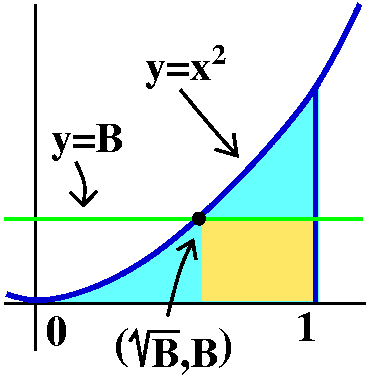 This is more difficult. Can we find the equation of a
horizontal line which will divide the region bounded by the
x-axis, x=1, and y=x2 into two equal parts?
This is more difficult. Can we find the equation of a
horizontal line which will divide the region bounded by the
x-axis, x=1, and y=x2 into two equal parts?
I think I called the horizontal line y=B in class. We want to find B
so that the area below y=B inside the region is 1/6, half of 1/3, as
before. But the area below the line can be computed by dividing it
into two pieces. The point where y=B interesects y=x2 has
B=x2, so the point is (sqrt(B),B). The vertical line
through that point combined with y=B cuts off a rectangle from the
area below y=B. The rectangle has one side (the vertical side) with
length equal to B. The horizontal side has length 1-sqrt(B). So the
area of the rectangle is B(1-sqrt(B)). The other part of the region
below y=B can be computed with an integral:
![]() 0sqrt(B)x2dx=(1/3)x3|0sqrt(B)=(1/3)(sqrt(B))3-(1/3)03=(1/3)(sqrt(B))3.
0sqrt(B)x2dx=(1/3)x3|0sqrt(B)=(1/3)(sqrt(B))3-(1/3)03=(1/3)(sqrt(B))3.
The total area is therefore
(1/3)(sqrt(B))3+B(1-sqrt(B)). The B wanted makes this equal
to 1/6. Maybe we made a mistake. Maybe there is no such B. Well, if
B=0, the formula's value is 0. If B=1, the formula's value is 1/3. I
bet (Intermediate Value Theorem, since the formula looks
continuous to me) that there is at least one B which makes the formula
equal to 1/6.
So we can solve it!
I thought in class that I would have to use numerical or graphical
methods to approximate a solution to the preceding equation. I was
wrong. Look:
(1/3)B3/2+B-B3/2=1/6
-4B3/2+3B-1=0
It turns out that this is
-(2B1/2-1)(2B-2B1/2-1)=0 and the roots of this
are B=1/4 from the first factor and B=(1/4)(1+sqrt(3))2
from the second factor. This was not at all clear to
me. Sigh. Maple, a computer program, factored this for
me. The only root in our domain (between 0 and 1) is 1/4. So y=1/4
will split the region into two pieces of equal area.
Another form of the FTC
I remarked that we had verified a special case of the following result
on Friday:
(d/dx)![]() axf(t) dt=f(x)
axf(t) dt=f(x)
So if you want
to differentiate a definite integral with a variable upper bound, you
get back the function whose area (?) you are computing.
Example (d/dx)![]() axsqrt(et+cos(t)) dt=ex+cos(x).
axsqrt(et+cos(t)) dt=ex+cos(x).
There are occasions when this result can be helpful. I don't think
we'll see them in the short time remaining in the course.
Bird of the day

The Common Loon
Gavia Immer.
Exponential integrals
FTC tells me
![]() 34exdx=ex|34=e4-e3.
34exdx=ex|34=e4-e3.
Then FTC tells me
![]() 345exdx=5ex|34=5e4-5e3.
345exdx=5ex|34=5e4-5e3.
And I can try to use FTC on
![]() 34e5xdx but first I
need an antiderivative. What function has derivative equal to
e5x? If I try e5x, the Chain Rule "spits out"
an extra 5. I need to compensate for that, so I will guess
(1/5)e5x, and this is correct. You can check by
differentiating that e5x is the derivative of
(1/5)e5x. Now let's compute using FTC:
34e5xdx but first I
need an antiderivative. What function has derivative equal to
e5x? If I try e5x, the Chain Rule "spits out"
an extra 5. I need to compensate for that, so I will guess
(1/5)e5x, and this is correct. You can check by
differentiating that e5x is the derivative of
(1/5)e5x. Now let's compute using FTC:
![]() 34e5xdx
=(1/5)e5x|34=(1/5)e5·4-(1/5)e5·3.
34e5xdx
=(1/5)e5x|34=(1/5)e5·4-(1/5)e5·3.
More complicated: just "guess"
I think I asked for a really weird indefinite integral, but the
weirdness was arranged carefully. Maybe it looked like:
![]() (5x3+48)100x2dx.
(5x3+48)100x2dx.
This is horrible, maybe, until you see some of the "structure" of the
expression. There's a 100th power. Maybe the antiderivative
should have a 101th power. But the Chain Rule implies
... well, there is an x2 already there ... maybe we
could somehow ...
If you continue dithering (dictionary: dither="hesitate; be
indecisive") you won't get anywhere. But a good guess (not really a
guess, an informed conjecture, let us say) leads to
(1/100)(1/5)(1/3)(5x3+48)101+C
Is this correct? I think so, but you can check it
easily. Differentiation is easy but antidifferentiation is
difficult. In this case, I hope when you check you will see first 100
then 5 then 3 get canceled by numbers excreted (?) by the Chain Rule.
The substitution method
The previous example should have convinced you that keeping track of
various numbers can get to be difficult. The Substitution Method, a
sort of Chain Rule in reverse, does help with all the numbers. It is
basically a method of bookkeeping
(an interesting word) applied to the constants which appear. Here is
how people use it.
Start with
![]() (5x3+48)100x2dx.
(5x3+48)100x2dx.
If u=5x3+48 then du/dx=15x2, and so (huh?)
du=15x2dx, and (1/15)du=x2dx. Therefore:
From x-land to u-land
![]() (5x3+48)100x2dx is
(5x3+48)100x2dx is ![]() u100(1/15) du.
u100(1/15) du.
The
antiderivative of this is (1/15)(1/101)u101+C since I know
how to find the antidervative of powers.
From u-land to x-land
Well since u=5x3+48, then (1/15)(1/101)u101+C
becomes (1/15)(1/101)(5x3+48)101+C and you can
check this is correct by differentiating. This is certainly the same
answer we got by guessing. Most people prefer this method, since there
are lots of mistakes which can be made by guessing.
HOMEWORK
Please study for the final exam. Do this by first working on the
homework problems in the last sections we will cover. Please.
|
Some definite integrals I drew the graph shown to the right, and stated that this was a graph of y=f(x). I then asked for the following definite integrals: Since I "identified" pieces of the curve as rather simple shapes, probably the integrals can be computed. |

|
|
Here the region is just a rectangle. The base is 2 units long, and the height is 1 unit, so that the area is 2. This is the value of the definite integral. | 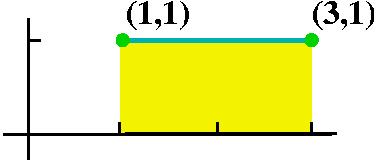 |
|
Here the region is a square and a triangle joined on a side. The square is 1 by 1 unit and has area 1. The triangle, with base and height both 1, has area 1/2. Therefore the definite integral, in this case measuring the total area, has value 1.5. |  |
|
The geometry is clear, but what the definite integral computes is sometimes not exactly what the geometry says. The Riemann sum definition of the definite integral makes area above the horizontal axis count positively and area below that axis, negatively. The picture below shows the signed area which a definite integral would compute. 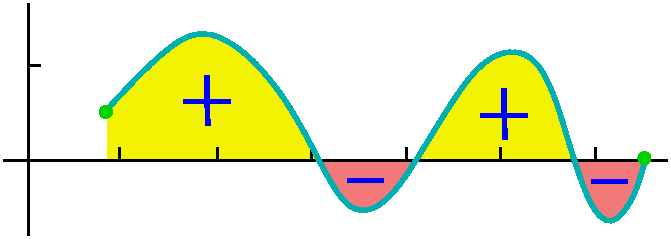 The sign of the definite integral in applications can have meaning
which is central to the computation: are those dollar amounts profit
or loss? Is there a net amount of fluid being pumped around the body,
or is there a backflow?
The sign of the definite integral in applications can have meaning
which is central to the computation: are those dollar amounts profit
or loss? Is there a net amount of fluid being pumped around the body,
or is there a backflow?In this case, the definite integral counts the triangle with positive area and the quarter circle with negative area. So the value of the definite integral is 1/2 -Pi(1)2/4. This is a negative number. | 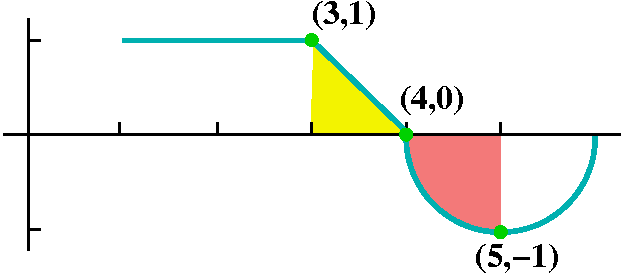 |
|
Here all of the curve is below the axis, and we will "count" all of the area negatively. This is half a circle of radius 1. The value of the definite integral is -Pi(1)2/2. | 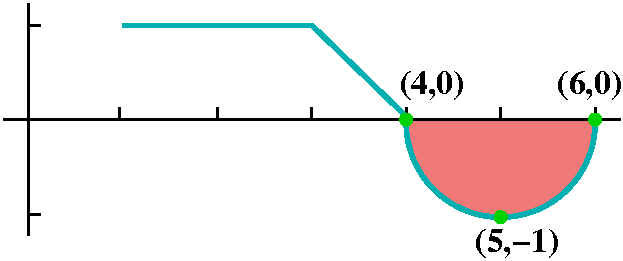 |
| MORE TOP SECRET |
|---|
| During the class meetings, I've had two ambitions. One ambition has been to show that the reasoning involving calculus is valid, and the other is to convince students of the relevance and utility of the subject. From 6 PM to 8 PM on Sunday, April 24, and Sunday, May 1 in Hickman 216 on Douglass I won't continue these attempts. Then I'll only try to help people do as well as possible on a Math 135 final exam. That's it. The students will do the work. I will be the host and guide. Please come, but please come motivated to work on this "stuff". |
Many of the methods of calculus have been discovered and rediscovered by different cultures over the last thousand or fifteen hundred years. Special successes have been achieved by efforts in China, India, Greece, and Egypt. I've seen copies of old manuscripts, with totally understandable diagrams, annotated in antique Chinese, Sanskrit, etc. It is wonderful to consider how such amazingly varied people have attempted (and, to a great extent) succeeded in approximation and computation of many strange quantities which we also have considered. I will describe a very simple example using methods which all of these participants would have understood.
 How to find the area of a triangle
How to find the area of a triangle
The triangle I'll look a region in the plane bounded by the x-axis,
the line x=1, and the line y=x. I'm interested in the process, not
just the answer. Here is an example of the process of approximation:
chop up the interval [0,1] into three equal parts. Use the right-hand
endpoints of each subinterval to determine the height of approximating
rectangles. Then compute the sum of the areas of the resulting
rectangles. In this example, the sum turns out to be
1 1 2 1 3 1 ---·--- + ---·--- + ---·--- 3 3 3 3 3 3because the width of each rectangle is 1/3, and the heights are 1/3 and 2/3 and 3/3 (or 1 but the 3/3's shows the pattern better). We can rewrite this as:
1 --- · (1+2+3) 32
What happens if we do the same process dividing the interval into n equal parts? I bet as n grows that the sum of the areas of the rectangles is closer to the area of the triangle. Also, I think I can guess that the algebraic form of the sum of the areas will be the following:
1 --- · (1+2+3+...+n) n2I want to analyze the asymptotic behavior of this as n-->infinity, because if there is a limit, the limit deserves to be called the area of the triangle. Here's a trick to get the sum of the simple arithmetic progression above. First, write the sum twice, once going up and, below it, going down. Then add up the quantitis from top to bottom. Each pair of numbers adds up to n+1 (as the top goes up, the bottom goes down). So the sum is n+1 and there are n pairs. Therefore the sum is (n+1)n.
1 + 2 + 3 + ... + (n-1) + n
n + (n-1) + (n-2) + ... + 2 + 1
The sums (columnwise):
n+1 n+1 n+1 + ... + n+1 + n+1 (n of these).
Since we started with two copies of 1+2+3+...+n,
I think we need to divide the result by 2. Therefore
1+2+3+...+n is [(n+1)n]/2.
Therefore the sum of the areas of the rectangles is
[(n+1)n]/[2n2]. What happens as n-->infinity?
We can apply l'Hopital's rule twice, but folks like Archimedes
(no, Irving was not his first name, darn it, the lecturer is
just too silly) would probably have analyzed this a bit differently.
Maybe they might have divided the top and bottom by n2
and gotten [1+{1/n}]/2 which gets darn close to 1/2.
So that's the classical procedure, which was invented and used with a great deal of effort by several different cultures. Let me now try what they all would consider a much more difficult area to approximate. I think all those folks could do this problem, but they would regard it as a bit challenging.
|
Another definite integral I would like to compute the area of the region which is bounded by y=x3, the x-axis, x=2, and x=7. The technology of the "old folks" could probably compute this area. The hard part would be finding a nice formula for 13+23+33+...+n3 but I think that they could do it. I want to solve this problem, that is, compute this area, by asking about a harder problem. (!) |
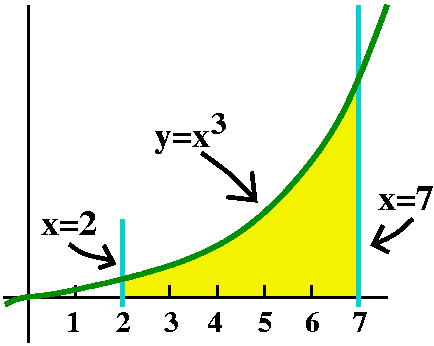
|
|
The harder problem Define a new function, A(R) (R is for right). This is an area function which will depend a varying right edge. So A(R) will be the area of the region whose boundary consists of a piece of y=x3, the x-axis, the line x=2, and the line x=R. The task is to understand A(R) well enough to compute A(7). The likely success of this approach is not clear at all, since we seem to have substituted a more difficult, and certainly a more general, problem for the one we started with. |
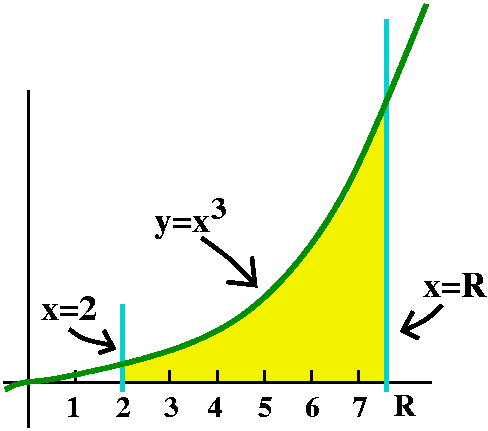
|
|
A silly value of A(R) Is there any specific value of A(R) we can "compute"? Well, the word "compute" may be too extravagant, but one value is almost obvious: A(2)=0. Look at the picture, and make the line x=R move inside your mind. Make it move left, until it coincides with x=2. I think the area gets smaller and smaller, until there is no area left. So A(2) should be 0. | |
|
Differentiate A(R) Well those "old folks" didn't have the advantage of more than 90% of a semester of Rutgers calculus. Maybe one thing we can assert is that we should almost always try to differentiate a function. To find the derivative we will need to understand A(R+h)-A(R). I hope the picture helps. h is supposed to be very small. The regions whose areas define A(R+h) and A(R) have a large overlap. When we subtract A(R+h)-A(R) the overlaps cancel, and we just have a thin sliver of area. The width of the sliver is h (that's the difference between R+h and R) and the height varies. On the left the height is R3 (since y=x3) and on the right the height is (R+h)3. |
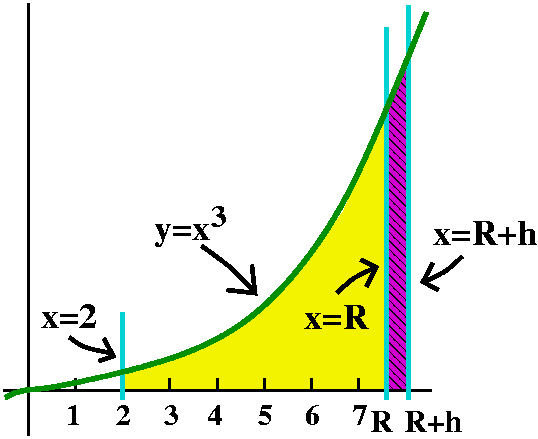
|
|
Now think and let h-->0 The "sliver" whose area is A(R+h)-A(R) contains a rectangular box whose height is R3 and whose width is h. So the sliver contains at least an area of R3h. But the sliver also is itself contained inside a box whose height is (R+h)3 and whose width is h. This box has area (R+h)3h. So I know R3h<A(R+h)-A(R)<(R+h)3h. Divide this by h and get R3<[{A(R+h)-A(R)}/h]<(R+h)3. As h-->0, both R3 and (R+h)3 go to R3, and, in the middle, the quotient [{A(R+h)-A(R)}/h] is squeezed. Its limit must also be R3. Therefore A(R) is differentiable, and A´(R)=R3 |
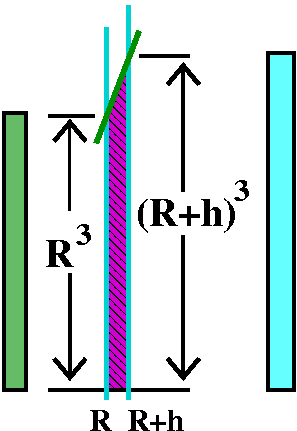
|
Now we solve it
We know the following about A(R):
A(2)=0;
A´(R)=R3.
Since A´(R)=R3 we know from our study of
differentiation that A(R) must be a function that can be written
(1/4)R4+C for some constant, C. But let's use the "initial
condition" A(2)=0. So plug in R=2 in the equation
A(R)=(1/4)R4+C and get A(2)=(1/4)24+C which is
supposed to be 0. Then C should be -(1/4)24. So now
A(R) is: precisely:
A(R)=(1/4)R4-(1/4)24.
Therefore, A(7), which is the quantity I wanted to get, must be
(1/4)74-(1/4)24.
Make it easier!
We want to compute
![]() 27x3 dx. Maybe first
let's guess some antiderivative of x3. My guess is
(1/4)x4+338. Plug in x=7 in this function and get
(1/4)74+338. Also plug in x=2 and get
(1/4)24+338. Compute the difference, and this difference is
[(1/4)74+338]-[(1/4)24+338]. This crazy number
is the value of the definite integral.
27x3 dx. Maybe first
let's guess some antiderivative of x3. My guess is
(1/4)x4+338. Plug in x=7 in this function and get
(1/4)74+338. Also plug in x=2 and get
(1/4)24+338. Compute the difference, and this difference is
[(1/4)74+338]-[(1/4)24+338]. This crazy number
is the value of the definite integral.
Notice, please, that the 338 doesn't really do anything to the
answer. You don't need to be lucky, because the constant just drops
out. Just guess any antiderivative and plug in and subtract.
A part of the Fundamental Theorem of Calculus
Suppose you know that F´(x)=f(x). Then
![]() abf(x) dx=F(b)-F(a).
abf(x) dx=F(b)-F(a).
There is even special notation for "F(b)-F(a)". Usually people will
write F(x)]ab or
F(x)|ab. The text uses the second version,
without the little hooks at the end. The text used when I was taught
calculus had the hooks, so surely I will slip sometimes and write them.
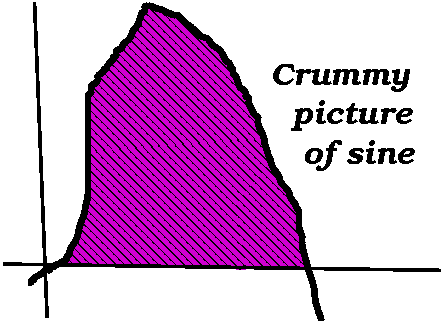 How big is the hump?
How big is the hump?
In fact, as students kindly (?) pointed out, I didn't state this too
precisely. Well, o.k.: look at the curve y=sin(x). What is the area
under the first bump of this sine curve? The accompanying picture
is supposed to be very sloppy. I wanted to emphasize the need to have
some size of the answer. I don't think the answer should be very large
(456 is too darn large). I don't think the answer should be very small
(1/456 is too darn small).
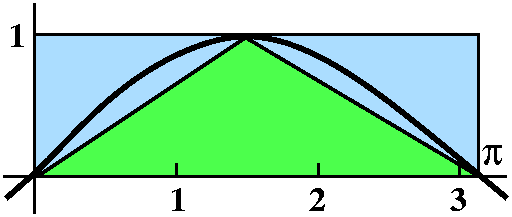 Although I sincerely hope that in most situations in the future you
will have computational help (machines!) you should have some idea of
the size of your answer, so that when the machine reports something
really far from the correct answer, you'll know enough to worry a bit.
So I try to imagine the answer. Look at the (better!) picture to the
right. The sine bump is inside a box whose height is 1 and whose width
is Pi, so the area, when we compute it, should be less than Pi. Also
the area under the bump contains a triangle (as shown) whose height is
1 which has a base of width Pi, so the area of the bump should be more
than Pi/2. Now maybe I will compute the area.
Although I sincerely hope that in most situations in the future you
will have computational help (machines!) you should have some idea of
the size of your answer, so that when the machine reports something
really far from the correct answer, you'll know enough to worry a bit.
So I try to imagine the answer. Look at the (better!) picture to the
right. The sine bump is inside a box whose height is 1 and whose width
is Pi, so the area, when we compute it, should be less than Pi. Also
the area under the bump contains a triangle (as shown) whose height is
1 which has a base of width Pi, so the area of the bump should be more
than Pi/2. Now maybe I will compute the area.
So I need ![]() 0Pisin(x) dx. I know a
function whose derivative is sin(x). Such a function is -cos(x) (keep
track of minus signs!). So the area is -cos(x)|0Pi. This is
-cos(Pi)-[-cos(0)]. This is -(-1)-(-1)=2 (keep track of minus signs!).
You can check that 2 is between Pi and Pi/2 as we thought it should
be.
0Pisin(x) dx. I know a
function whose derivative is sin(x). Such a function is -cos(x) (keep
track of minus signs!). So the area is -cos(x)|0Pi. This is
-cos(Pi)-[-cos(0)]. This is -(-1)-(-1)=2 (keep track of minus signs!).
You can check that 2 is between Pi and Pi/2 as we thought it should
be.
How about the area under a bump of cosine?
Maybe this area should be
![]() 0Picos(x) dx. An antiderivative of
cos(x) is sin(x), so this definite integral is sin(x)|0Pi=sin(Pi)-sin(0)=0.
0Picos(x) dx. An antiderivative of
cos(x) is sin(x), so this definite integral is sin(x)|0Pi=sin(Pi)-sin(0)=0.
Hey! Is there no area? Well, maybe there is area but the
definite integral is 0. Remember, area above the horizontal
axis counts + and area below the
horizontal axis counts -.
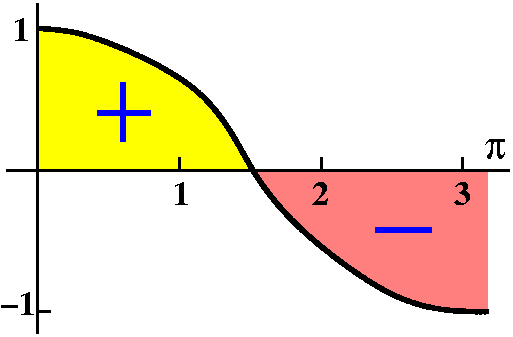
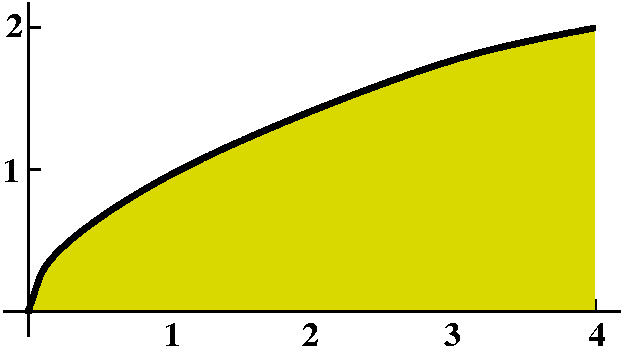 How about the area under square root?
How about the area under square root?
What's the area under y=sqrt(x) between 0 and 4? This is
![]() 04sqrt(x) dx. Change sqrt(x) to
x1/2. Then an antiderivative is (2/3)x3/2, so that
04sqrt(x) dx. Change sqrt(x) to
x1/2. Then an antiderivative is (2/3)x3/2, so that
![]() 04sqrt(x) dx=(2/3)x3/2|04
(2/3)43/2-(2/3)03/2. The number turns out to be
16/3. You can compare this again with the area of an enclosing
rectangle (area 2·4=8) and a triangle inside (area
(2·4)/2=4).
04sqrt(x) dx=(2/3)x3/2|04
(2/3)43/2-(2/3)03/2. The number turns out to be
16/3. You can compare this again with the area of an enclosing
rectangle (area 2·4=8) and a triangle inside (area
(2·4)/2=4).
What about the old folks?
I certainly believe that appropriate representatives from the
classical cultures of China, India, and Greece could do perform all of
the computations we did today. (I'm not sure about Egypt.) But all of
the computations would require extensive effort. Each computation
would be, in the social context, a tour de force, "a masterly
or brilliant feat". We have saved knowledge and built upon the efforts
of many clever people: the computations are now routine, and can even
be mechanized (e.g., Maple, etc.).
Michelin
This business, founded in France, was and still is a tire company. It
opened a factory near New Brunswick in the early part of the twentieth
century and "imported" Hungarian workers for the
factory. This was one of the origins of the Hungarian presence in New
Brunswick. Michelin also wanted to increase recreational car
driving. So it began publishing tour guides and collections of
restaurant reviews. Those attractions which were rated the best were
called, "vaut-le-voyage", that is, worth a journey just for
themselves. My claim is that the Fundamental Theorem of Calculus may
make Math 135 vaut-le-voyage. You should decide.
| Correction! Correction!! Correction!!! | |
|---|---|
| I woke up the morning after this class, and worried. My
scholarly conscience, which I too rarely consult, bothered me. I
worried about whether what I told you above (Michelin, etc.) was
correct. First I checked the web but couldn't find anything
definitive. Then I looked at the recently published and wonderful Encyclopedia of
New Jersey, trying to find connections between Michelin, New
Brunswick, and Hungarians. Again, there was not enough information. So
I sent e-mail asking for help to an acquaintance, Dr. Marc Mappen,
who was one of the coeditors of the Encyclopedia and is
executive director of the New Jersey Historical Commission. He very
kindly got further and much better information from participants on
the New Jersey history listserv. Here is most of one reply from
Mr. Bruce B. Reynolds. I conflated ("blend or fuse together
(esp. two variant texts into one)") some real history.
|
| TOP SECRET |
|---|
| So, anyway, I would prefer that students in this course be
successful. A major measurement of success is performance on the
final. I'd like to help students do well on the final. Here is what I
will do:
I will act as a host and guide to review for the final exam. Hickman 216 on Douglass has been reserved on two successive Sunday evenings, from 6 PM to 8 PM: Sunday, April 24, and Sunday, May 1. The reason for choosing such weird and unconventional (uncomfortable?) times is that maybe people might have more freedom to attend than if some standard hours were picked. In the first session, I will try to intelligently select problems which originate from the first half of the course, and in the first session, problems from the second half of the course. The rooms will be announced by Friday. Rules of the game
|
|
Blood flow Suppose we now consider the following interesting physiological problem. A diagram of the human heart is shown. Blood flow through various "pipes" in the system is known to be an important indicator of health. How can we measure the blood flow through the aorta, the major artery emerging from the heart? | 
|
|
The Aztec solution One method might be to take a knife, preferably an obsidian knife, and rapidly cut through the chest wall, sever the aorta, and cause the blood that would flow through it to fill up a bucket. In about five minutes we'd probably have a good idea of how much blood flows through the aorta. There are several criticisms possible of this "protocol". One namby-pamby criticism (my online dictionary declares that "namby-pamby" means "insipidly pretty or sentimental") might be that, well, maybe the person involved might not be good for much afterwards. Another criticism could be that this would not show the actual pumping capacity of the aorta, because maybe within a minute or two some ... difficulties would occur. In some sense, this Aztec protocol is the ultimate in what might be called destructive testing. |

|
Another solution: cardiac catheterization
The American Heart Association and the NIH (National Institutes of
Health) both have lots of information about this. So:
| At the end of |
Minute #1 | Minute #2 | Minute #3 | Minute #4 | Minute #5 |
|---|---|---|---|---|---|
| blood flow rate is |
30 cc/min | 26 cc/min | 28 cc/min | 36 cc/min | 24 cc/min |
As I mentioned in class, maybe the reason for the jump at the fourth
minute is because a calc instructor walked into the room and murmured,
"Chain Rule!" How can we use this information to get an
approximation to the "real" blood flow? You might make the assumption
that, hey, maybe the flow rate doesn't change too much in a minute,
and maybe we can approximate the total blood flow by assuming the flow
rate is constant during that minute. So then during the first minute,
when the only measurement we have is 30 cc/min (cubic cows? no, cubic
centimeters), we could conclude that during the first minute the total
flow is (30 cc/min)·(1 min).
The units cooperate --
that is, the minutes cancel, and we see that 30 cc's (maybe) flowed
through
the aorta in the first minute. During the second minute, we have the
measuement (at the end of the second minute) of 26 cc/min. Therefore,
same (perhaps and probably not totally correct) assumptions show that
blood flow in the second minute is (26 cc/min)·(1 min).
Etc.. The answer that we can get from the
information supplied seems to be:
(30 cc/min)·(1 min)+(26 cc/min)·(1 min)+(28 cc/min)·(1 min)+(36 cc/min)·(1 min)+(24 cc/min)·(1 min).
I am not interested in these particular numbers, but I am very interested
in the ideas they represent.
A better approximation
We might want a better approximation to the blood flow. I
do not think it is realistic to assume that blood flow is steady, and
jumps only at the minute marks. To improve our information, with just as
much investmant in the (imagined!) equipment, we could (imagine!)
examining and recording flow rates every 30 seconds during the 5
minutes. We might get some data like this:
| At the end of |
30 seconds | Minute #1 | 1 minute 30 seconds |
Minute #2 | 2 minutes 30 seconds |
Minute #3 | 3 minutes 30 seconds |
Minute #4 | 4 minutes 30 seconds |
Minute #5 |
|---|---|---|---|---|---|---|---|---|---|---|
| blood flow rate is |
26 cc/min | 30 cc/min | 27 cc/min | 26 cc/min | 29 cc/min | 28 cc/min | 31 cc/min | 36 cc/min | 38 cc/min | 24 cc/min |
Again, there are lots of numbers. So what? How can we use these
numbers? To begin, how could we use the measurement at 30 seconds? We
could assume the flow rate of 29 cc/min is constant during that
initial 30 seconds. Then the blood flow would be ... well, should I
write 29·30? No: we shouldn't get confused about units. The
time is in minutes, so 30 seconds is (1/2) minute. In fact, the new
information allows us to write the following (probably better)
approximation to the blood flow: (I am omitting the units here because
I am a math geek.)
(26)·(1/2)+(30)·(1/2)+(27)·(1/2)+(26)·(1/2)+(29)·(1/2)+(28)·(1/2)+(31)·(1/2)+(36)·(1/2)+(38)·(1/2)+(24)·(1/2).
What is going on? The number of terms to add is increasing, but if you look very very carefully you will see that each term individually is getting smaller. In fact, these changes nearly balance: more terms/smaller terms. The totals are different, but not very different. The new total is "better", a refinement of the old sum. The approach here is computational and numerical, and for me obscures what's going on. A collection of pictures actually provides far more information for me here.
|
Approximating what, "exactly"? Well, we began by using only the information at five different times, at the end of each minute. If we were to plot points on a graph of blood flow, we would see the picture to the right. The first sum we wrote is exactly the total area under the five boxes shown, with "area" interpreted as the amount of blood. |
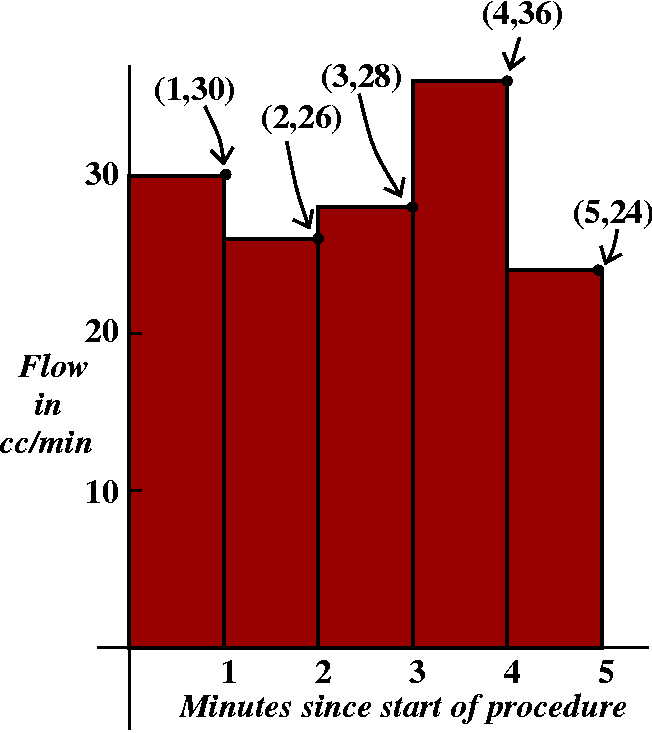
|
| When we put in the data points at 30 second intervals, we can see pictorically exactly what that second crazy sum represents: it is the total area in the boxes of width (1/2) minute, with "area" interpreted as the amount of blood. |
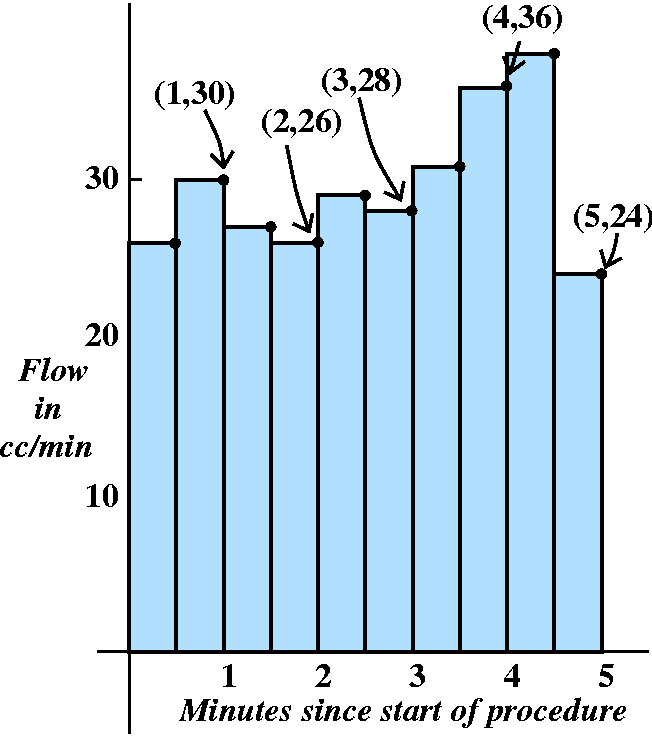
|
| Now what do the "Aztecs" get as their information? We could imagine a flow rate function which sort of threads its way through the data points supplied. The Aztecs, with the ridiculous bucket holding exactly the blood going through the aorta, would have an amount of blood which is exactly the area under the blood rate flow graph. You can see that we have these rectangular approximations to the area which we hope get better as the rectangles get thinner and the number of samples of the flow rate increases. |
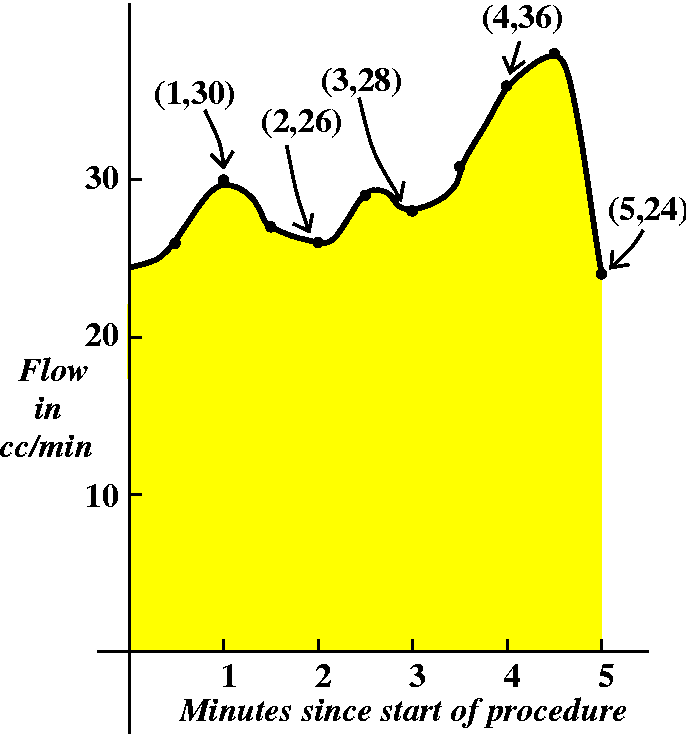
|
Future value of an income stream
I wanted to give an economic example of the same sort of sum, and I
tried to discuss the future value of an income stream. I think I lost
even the people with the most knowledge of the field here, and I am
sorry. The idea is that you get a certain number of dollars paid back
to you over a period of time. The total amount paid is always the same, but
the paybacks are in chunks which get smaller as the number of payments
increase. I then assumed that the paybacks are reinvested, and the
value with interest as the end of the time is totaled. This is called
the future value of an income stream. This may seem rather weird to
you: I'm sorry. Here is
a lecture from a math course at the University of Wisconsin which
discusses the topic in more detail. I am sorry I covered it so
hastily. The idea is difficult.
More vocabulary: calcspeak grows!
I will try to use the notation in your text (section 5.3).
We begin with a function f(x) defined (at least) on an interval
a<=x<=b. Divide the interval up with a bunch of points. This is
called a partition. The textbook writes this as
a=x0<x1<x2<...<xn-1<xn=b.
Now in each "little" subinterval choose a sample point: so
x1* is in the interval with endpoints
x0 and x1,
x2* is in the interval with endpoints
x1 and x2,
...
xn* is in the interval with endpoints
xn-1 and xn.
Evaluate f(x) at each sample point: f(x1*),
f(x2*),
f(x3*), ...,
f(xn*). Multiply each of these numbers by the
width of the subinterval they came from:
f(x1*)·(x1-x0),
f(x2*)·(x2-x1),
f(x3*)·(x3-x2), ...,
f(xn*)·(xn-xn-1).
Add up all these numbers. The result is called a Riemann sum corresponding to these choices of partition, sample points, function, latitude, irritation ... of course I am joking about the last two. But this "thing" is a very complicated object. I think some examples would be good.
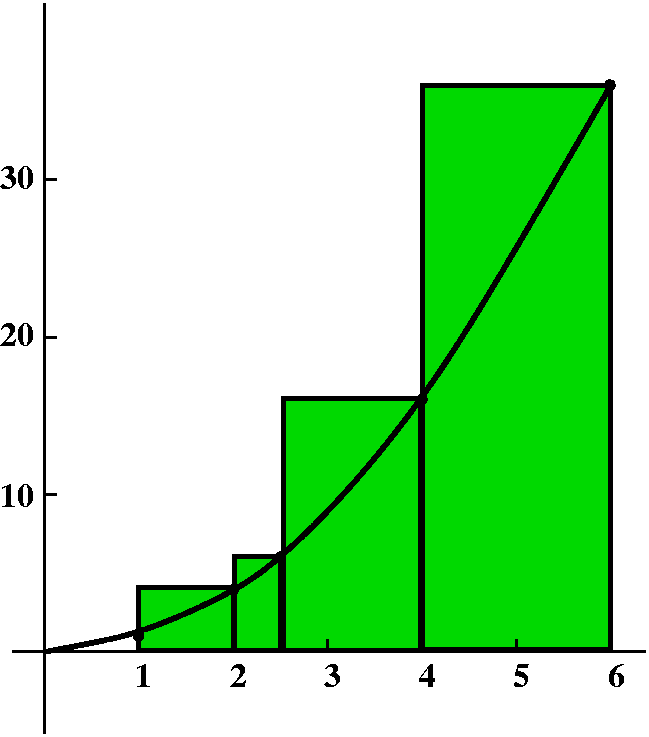 Example 1
Example 1
f(x)=x2. The interval is 1<=x<=6. The partition is,
let's say, x0=1 and x1=2 and x2=2.5 and
x3=4.5 and x4=6. Also I need to specify the
sample points, and these will be the right-hand endpoints of each
subinterval.
So for x0=1 and x1=2, we have
x1*=2 and
f(x1*)=22. So we get a contribution
of 22(2-1).
So for x1=2 and x2=2.5, we have
x2*=2.5 and
f(x2*)=(2.5)2. So we get a contribution
of (2.5)2(2.5-2).
So for x2=2.5 and x3=4.5, we have
x3*=4.5 and
f(x3*)=(4.5)2. So we get a contribution
of (4.5)2(4.5-2.5).
So for x3=4.5 and x4=5, we have
x4*=5 and
f(x4*)=52. So we get a contribution
of 52(5-4.5).
The Riemann sum is therefore:
22(2-1)+(2.5)2(2.5-2)+(4.5)2(4.5-2.5)+52(5-4.5).
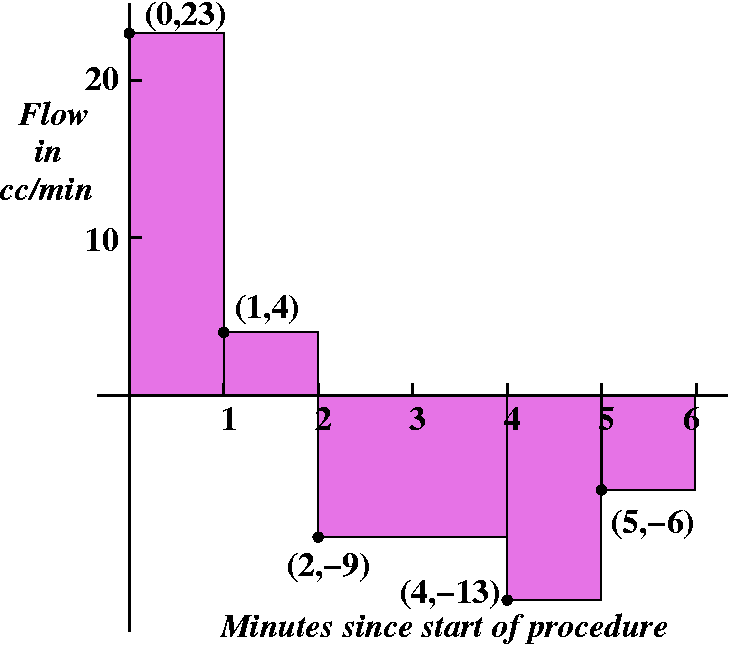 Example 2
Example 2
Here I gave some data on a graph. It is another blood measurement
proceedure. At time 0 (minutes), we have 23 (cc's/min). I will omit
the units from now on, since reality is receding from me at 77
furlongs per fortnight. Other observations during this proceedure,
which lasts from time 0 to time 6, are (1,4), (2,-9), (4,-13),
(5,-6). You may question the "reality", even remote, of negative
readings. Well, unfortunately, that can be real. Valves in hearts and
other places can leak, and there can be backflow. Here my sample
points will be the left-hand endpoints of the intervals. And my
Riemann sum will be:
23(1)+4(1)+(-9)2+(-13)1+(-6)1.
This total does happen to be negative, so I think the net effect of
the "flow" is a backwards slosh of liquid.
In financial computations, positive could represent profit and
negative could represent loss. Unfortunately in the real world,
negative sums can occur. Sigh.
The definite integral
As the number of points in the partition increases, as the length of
the subintervals approaches 0, if the function involved is fairly nice
(let's say piecewise continuous, which is continuous except
maybe for a finite number of jumps) then the sums (properly, the
Riemann sums), for any possible selection of sample points, approach a
unique limit, which is called the definite integral of f(x) from a to
b. I have so far omitted the rather wild traditional notation. Well,
if you look in the text you will see that Riemann sums themselves are
frequently abbreviated with capital Greek sigmas. I won't even write
these in class. But the notation for the definite integral is one
which I will need to use. Here it is:
![]() ab
f(x) dx
ab
f(x) dx
The long "S" is an abbreviation for Sum. So you can look at this notation and see
that it is an abbreviation for summing up, as x goes from a to b, the
"rectangles" of height f(x) and width dx. Here "dx" stands for some
really really really small width.
HOMEWORK
Please read the first four sections of chapter 5 and hand in these
problems on Thursday:
5.1: 43, 44;
5.2: 13a, 19;
5.3: 26, 27.
Maintained by greenfie@math.rutgers.edu and last modified 4/19/2005.